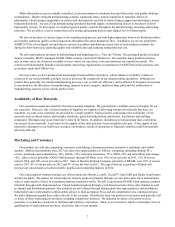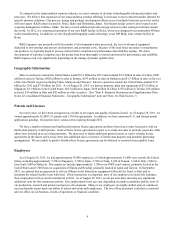Crucial 2013 Annual Report Download - page 18
Download and view the complete annual report
Please find page 18 of the 2013 Crucial annual report below. You can navigate through the pages in the report by either clicking on the pages listed below, or by using the keyword search tool below to find specific information within the annual report.17
On January 17, 2013, we entered into agreements with Nanya Technology Corporation ("Nanya") to amend the joint
venture relationship involving Inotera. Under the Inotera Supply Agreement we purchase substantially all of Inotera's output at
a purchase price based on a discount from actual market prices for comparable components. The Inotera Supply Agreement
was retroactively effective beginning on January 1, 2013. For the fourth quarter of 2013, we purchased $518 million of DRAM
products from Inotera and our supply from Inotera accounted for 50% of our aggregate DRAM gigabit production. If our
supply of DRAM from Inotera is impacted, our business, results of operations or financial condition could be materially
adversely affected.
Changes in foreign currency exchange rates could materially adversely affect our business, results of operations or
financial condition.
Across our multi-national operations, there are transactions and balances denominated in currencies other than the U.S.
dollar (our reporting currency), primarily the Singapore dollar, euro, shekel and yen. We recorded net losses from changes in
currency exchange rates of $229 million for 2013, $6 million for 2012 and $6 million for 2011. Based on our foreign currency
exposures from monetary assets and liabilities, offset by balance sheet hedges, we estimate that a 10% adverse change in
exchange rates versus the U.S. dollar would result in losses of approximately $19 million as of August 29, 2013. In the event
that the U.S. dollar weakens significantly compared to the Singapore dollar, euro, shekel or yen, our results of operations or
financial condition may be adversely affected.
In connection with the Elpida Sponsor Agreement and Rexchip Share Purchase Agreement, we entered into currency
hedges to mitigate the risk that increases in exchange rates have on our planned yen payments. In 2013, we recognized losses
of $228 million on these hedges and made payments of $222 million to settle these hedges. As of August 29, 2013, to hedge
certain yen-denominated payments resulting from our acquisition of Elpida, we had an outstanding forward contract to purchase
20 billion yen on November 28, 2014 at a yen per U.S. dollar exchange rate of 98.53 and a forward contract to purchase 10
billion yen on November 27, 2015 at a yen per U.S. dollar exchange rate of 97.25.
The financial crisis and overall downturn in the worldwide economy may harm our business.
The financial crisis and the overall downturn in the worldwide economy have had an adverse effect on our business. A
continuation or further deterioration of depressed economic conditions could have an even greater adverse effect on our
business, including any economic downturn resulting from the shutdown of the U.S. federal government or any default by the
U.S. federal government on any of its debt or other obligations. Adverse economic conditions affect demand for devices that
incorporate our products, such as personal computers, networking products and mobile devices. Reduced demand for these
products could result in significant decreases in our average selling prices and product sales. A deterioration of current
conditions in worldwide credit markets would limit our ability to obtain external financing to fund our operations and capital
expenditures. In addition, we may experience losses on our holdings of cash and investments due to failures of financial
institutions and other parties. Difficult economic conditions may also result in a higher rate of loss on our accounts receivables
due to credit defaults. As a result, our business, results of operations or financial condition could be materially adversely
affected.
We may incur additional material restructure or other charges in future periods.
In response to severe downturns in the semiconductor memory industry and global economic conditions, we implemented
restructure activities and may implement restructure initiatives in future periods. We may restructure or dispose of assets as we
continue to optimize our manufacturing operations, including the wind-down of 200-millimeter wafer capacity as we migrate
more products to 300-millimeter wafer production. As a result, we could incur restructure charges (including but not limited to
severance and other termination benefits, losses on disposition or impairment of equipment or other long-lived assets and
inventory write downs), lose production output, lose key personnel and experience disruptions in our operations and difficulties
in the timely delivery of products. In connection with these actions, we recorded $126 million in 2013 and may incur
restructure charges or other losses associated with other initiatives in future periods.
We may make future acquisitions and/or alliances, which involve numerous risks.
Acquisitions and the formation or operation of alliances, such as joint ventures and other partnering arrangements, involve
numerous risks including the following:
• integrating the operations, technologies and products of acquired or newly formed entities into our operations;
• increasing capital expenditures to upgrade and maintain facilities;
• increased debt levels;
























